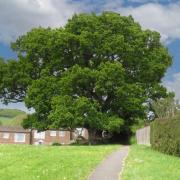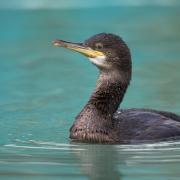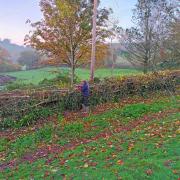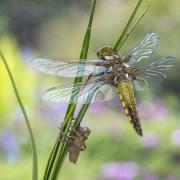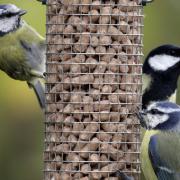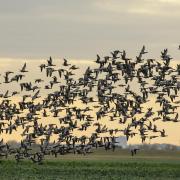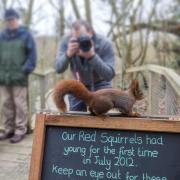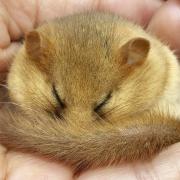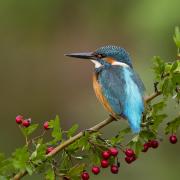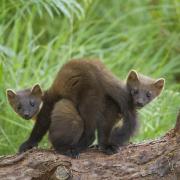Birdwatching is a great activity for little ones.It both keeps them entertained and introduces them to wildlife
Birdwatching with Bertie
Birdwatching is a great activity for little ones. It both keeps them entertained and introduces them to wildlife
Words and photos by Emma Dolphin and Courtesy of RSPB
The hour is early and there is a continuous, slightly disgruntled sound emitting from Bertie’s room. Typically it is a weekend and when all else fails to soothe our two-year-old son, my husband opens the curtains. Living in the upper two floors of a converted town house, we have a bird’s eye view over Crediton and its surrounding countryside. Perfect for birdwatching.
Bertie looks furtively out the window. “Coo,” he utters as he points to his favourite bird, the wood pigeon sitting snugly in the oak tree. He attempts to count the number of pigeons he can see “One, two. three….four!” he announces proudly. All of them have puffed up their feathers to keep out the chill of the February air. Silence descends as he waits for others to come in to view. A very small bird lands in the tree, flitting from one branch to the next, barely appearing to pause for breath. This is a goldcrest and its energetic movements are reminiscent of my son’s when he scampers about outdoors.
A wren lands on the shed roof and flicks its tail agitatedly. Its time in the open is brief as with another tail flick it appears to jump off the roof to seek shelter in the brambles along the hedge. “Wren fall over,” comments Bertie. “Yes, the wren flew off, Bertie,” replies my husband. I wait eagerly to see if we will be provided with the Jenny Wren’s showpiece - a powerful song full of trills and warbles which belies its small size. Instead we hear a dunnock. Its song is similar to the robin’s but less melodic, more repetitive and almost tin-like in quality. The dunnock emerges from the undergrowth and hops along the wall. It bobs around for a minute or two before it too retreats to the sanctuary of the brambles.
The robin when it does arrive is not so shy. It perches on top of the small twig, which is our dwarf apple tree, and the small beginnings of what will one day be our orchard. In contrast to the other birds, the robin flaunts himself boldly from his perch, almost daring the plethora of local cats to take him on.
In the fields beyond Bertie catches sight of a blackbird. He starts pointing wildly as we see house sparrows, blue-tits, great tits, coal tits and greenfinches coming into view. He emits a screech imitating the herring gull that flies overhead. A black-headed gull in its winter plumage, with the distinctive black spot behind the eye, soars by the window. Calmed by this wildlife spectacle, Bertie’s attentions turn to more urgent needs as he needs re-fuelling “Please porridge”. We leave the birds behind as we head for the kitchen and a warming breakfast.
Later whilst playing with his cars in the lounge he stands up suddenly, pointing at the window “Craa”. I am slightly mystified until I also peer out and see a crow sitting on top of its nest!
I will have to wait another day to see if my favourite bird, the long-tailed tit, will pay us a visit. These small white, black and pink birds always seem to be smiling.
Top ten winter birds found in Devon
These are the top ten bird species recorded in Devon in 2010 as part of the rspb big Garden bird watch. this is an annual survey, taking place in January, where you can count the number of different birds in your garden, local park or school grounds.1. house sparrow 2. blackbird3. Chaffinch 4. blue tit5. starling 6. robin7. Great tit 8. Woodpigeon9. Goldfinch10. Dunnock
Tips for birdwatching with children
As an ecologist with a zooIogist for a husband, it was inevitable that we would find any excuse to go exploring for wildlife with Bertie. I find his enthusiasm infectious as he relishes new experiences... watching a spider spin its webs and sniffing flowers in full bloom. In the summer we spent half an hour investigating a grit bin as he wanted to point out every aphid, ant and spider he could find crawling on it! I would love to encourage more children to enjoy nature. Toddlers in particular are naturally curious of the world around them. Bird watching is a great activity to keep your little ones entertained and introduces them to wildlife. You can do it in all weathers and in the sanctuary of your own home. Small children have short attention spans though so initially half an hour at a time is ample.
To encourage a greater variety of our feathered friends into the garden, we have introduced a couple of bird feeders. One is filled with sunflower hearts and the other a mixture of suet pellets and grains. In previous years half a coconut shell filled with a bird cake mix of suet, grains and mealworms proved particularly popular; the food had been eaten within a couple of days of hanging it out!
Take care when placing your feeders though as birds like some cover and protection from predators when they eat. Hanging a feeder from a branch of tree that you can see easily from your window is a good idea. You can get some that attach directly to the window. I used to have one, filled with peanuts, which was frequented by a great spotted woodpecker hammering on it in the early hours of the morning!






